Deck 14: Conjugation,resonance,and Dienes
Question
Question
Question
Question
Question
Question
Question
Question
Question
Question
Question
Question
Question
Question
Question
Question
Question
Question
Question
Question
Question
Question
Question
Question
Question
Question
Question
Question
Question
Question
Question
Question
Question
Question
Question
Question
Question
Question
Question
Question
Question
Question
Question
Question
Question
Question
Question
Question
Question
Question
Question
Question
Question

Unlock Deck
Sign up to unlock the cards in this deck!
Unlock Deck
Unlock Deck
1/53
Play
Full screen (f)
Deck 14: Conjugation,resonance,and Dienes
1
What is (are)the major product(s)of the following reaction? 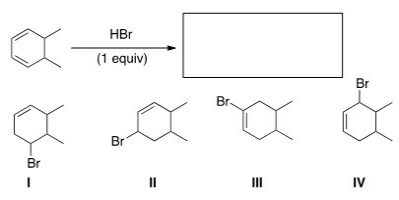
A)Only I
B)Only II and IV
C)Only I and III
D)Only I,II,and III

A)Only I
B)Only II and IV
C)Only I and III
D)Only I,II,and III
Only II and IV
2
Rank the following dienes in order of decreasing heat of hydrogenation,putting the diene with the highest heat of hydrogenation first. 
A)I > II > III
B)III > II > I
C)II > I > III
D)III > I > II

A)I > II > III
B)III > II > I
C)II > I > III
D)III > I > II
III > I > II
3
Which of the following is the appropriate term for the mechanism of the addition of HBr to 1,3-dienes?
A)Nucleophilic addition
B)Electrophilic addition
C)Free radical addition
D)Conjugate addition
A)Nucleophilic addition
B)Electrophilic addition
C)Free radical addition
D)Conjugate addition
Electrophilic addition
4
What is the hybridization around the indicated carbon atom in the following anion? 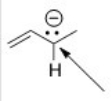
A)sp3
B)sp2
C)sp
D)p

A)sp3
B)sp2
C)sp
D)p

Unlock Deck
Unlock for access to all 53 flashcards in this deck.
Unlock Deck
k this deck
5
Which of the following is (are)conjugated dienes? 
A)Only I
B)Only II
C)Only I and II
D)I,II,and III

A)Only I
B)Only II
C)Only I and II
D)I,II,and III

Unlock Deck
Unlock for access to all 53 flashcards in this deck.
Unlock Deck
k this deck
6
Which of the following dienes contain conjugated double bonds? 
A)Only I and II
B)Only II and III
C)Only I and III
D)Only II and IV

A)Only I and II
B)Only II and III
C)Only I and III
D)Only II and IV

Unlock Deck
Unlock for access to all 53 flashcards in this deck.
Unlock Deck
k this deck
7
Which of the following statements about the mechanism of the Diels-Alder reaction is true?
A)Three π bonds break; two σ bonds and one π bond form.
B)Three π bonds break; one σ bond and two π bonds form.
C)Two π bonds break; one σ bond and one π bond form.
D)Two π bonds break; two σ bonds and one π bond form.
A)Three π bonds break; two σ bonds and one π bond form.
B)Three π bonds break; one σ bond and two π bonds form.
C)Two π bonds break; one σ bond and one π bond form.
D)Two π bonds break; two σ bonds and one π bond form.

Unlock Deck
Unlock for access to all 53 flashcards in this deck.
Unlock Deck
k this deck
8
Which of the following statements about resonance structures is true?
A)The placement of atoms is different.
B)The placement of p bonds is different.
C)The placement of s bonds is different.
D)The placement of nonbonded electrons is the same.
A)The placement of atoms is different.
B)The placement of p bonds is different.
C)The placement of s bonds is different.
D)The placement of nonbonded electrons is the same.

Unlock Deck
Unlock for access to all 53 flashcards in this deck.
Unlock Deck
k this deck
9
Which of the following dienes contain isolated double bonds? 
A)Only I and II
B)Only II and III
C)Only I and III
D)Only II and IV

A)Only I and II
B)Only II and III
C)Only I and III
D)Only II and IV

Unlock Deck
Unlock for access to all 53 flashcards in this deck.
Unlock Deck
k this deck
10
Rank the following compounds in order of increasing stability,putting the least stable first. 
A)I < II < III
B)III < II < I
C)II < I < III
D)III < I < II

A)I < II < III
B)III < II < I
C)II < I < III
D)III < I < II

Unlock Deck
Unlock for access to all 53 flashcards in this deck.
Unlock Deck
k this deck
11
Which of the following is not a product obtained from the addition of 1 equivalent of HBr to (E)-1,3-pentadiene?
A)(E)-4-Bromo-2-pentene
B)(E)-1-Bromo-2-pentene
C)3-Bromo-1-pentene
D)(E)-3-Bromo-2-pentene
A)(E)-4-Bromo-2-pentene
B)(E)-1-Bromo-2-pentene
C)3-Bromo-1-pentene
D)(E)-3-Bromo-2-pentene

Unlock Deck
Unlock for access to all 53 flashcards in this deck.
Unlock Deck
k this deck
12
What is the thermodynamic product obtained from the addition of 1 equivalent of HBr to 1,3-butadiene?
A)3-Bromo-1-butene
B)1-Bromo-2-butene
C)2-Bromo-2-butene
D)2-Bromo-1-butene
A)3-Bromo-1-butene
B)1-Bromo-2-butene
C)2-Bromo-2-butene
D)2-Bromo-1-butene

Unlock Deck
Unlock for access to all 53 flashcards in this deck.
Unlock Deck
k this deck
13
Which of the following statements about kinetic vs.thermodynamic products is true?
A)The product that is formed faster is the thermodynamic product.
B)The kinetic product predominates at low temperature.
C)The product that predominates at equilibrium is the kinetic product.
D)The thermodynamic product is less stable.
A)The product that is formed faster is the thermodynamic product.
B)The kinetic product predominates at low temperature.
C)The product that predominates at equilibrium is the kinetic product.
D)The thermodynamic product is less stable.

Unlock Deck
Unlock for access to all 53 flashcards in this deck.
Unlock Deck
k this deck
14
Which of the following conjugated dienes represent two conformations? 
A)Only I and II
B)Only I and III
C)Only II and III
D)None of the choices

A)Only I and II
B)Only I and III
C)Only II and III
D)None of the choices

Unlock Deck
Unlock for access to all 53 flashcards in this deck.
Unlock Deck
k this deck
15
What is the kinetic product obtained from the addition of 1 equivalent of HBr to 1,3-butadiene?
A)3-Bromo-1-butene
B)1-Bromo-2-butene
C)2-Bromo-2-butene
D)2-Bromo-1-butene
A)3-Bromo-1-butene
B)1-Bromo-2-butene
C)2-Bromo-2-butene
D)2-Bromo-1-butene

Unlock Deck
Unlock for access to all 53 flashcards in this deck.
Unlock Deck
k this deck
16
What is the hybridization around the indicated oxygen atom in the following anion? 
A)sp3
B)sp2
C)sp
D)p

A)sp3
B)sp2
C)sp
D)p

Unlock Deck
Unlock for access to all 53 flashcards in this deck.
Unlock Deck
k this deck
17
What is the reactive intermediate in the reaction of 1,3-diene with HBr,resulting in 1,4-addition?
A)Allylic radical
B)Cyclic bromonium
C)Dienophile
D)Allylic carbocation
A)Allylic radical
B)Cyclic bromonium
C)Dienophile
D)Allylic carbocation

Unlock Deck
Unlock for access to all 53 flashcards in this deck.
Unlock Deck
k this deck
18
What is (are)the major product(s)of the following reaction? 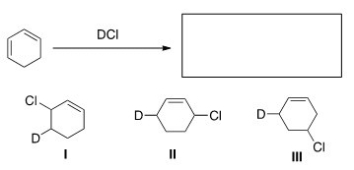
A)Only I
B)Only II
C)Only I and II
D)I,II,and III

A)Only I
B)Only II
C)Only I and II
D)I,II,and III

Unlock Deck
Unlock for access to all 53 flashcards in this deck.
Unlock Deck
k this deck
19
What is (are)the major product(s)of the following reaction? 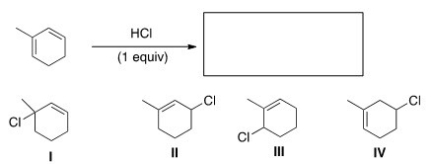
A)Only I
B)Only I and III
C)Only II and IV
D)Only I,II,and III

A)Only I
B)Only I and III
C)Only II and IV
D)Only I,II,and III

Unlock Deck
Unlock for access to all 53 flashcards in this deck.
Unlock Deck
k this deck
20
Which of the following compounds is conjugated? 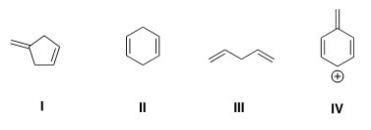
A)I
B)II
C)III
D)IV

A)I
B)II
C)III
D)IV

Unlock Deck
Unlock for access to all 53 flashcards in this deck.
Unlock Deck
k this deck
21
Which of the following is the most reactive diene in a Diels-Alder reaction? 
A)I
B)II
C)III
D)IV

A)I
B)II
C)III
D)IV

Unlock Deck
Unlock for access to all 53 flashcards in this deck.
Unlock Deck
k this deck
22
Rank the following dienes in order of increasing reactivity in a Diels-Alder reaction,listing the least reactive first. 
A)I< II < III
B)III < I < II
C)II < I < III
D)I < III < II

A)I< II < III
B)III < I < II
C)II < I < III
D)I < III < II

Unlock Deck
Unlock for access to all 53 flashcards in this deck.
Unlock Deck
k this deck
23
What is the major organic product of the following reaction? 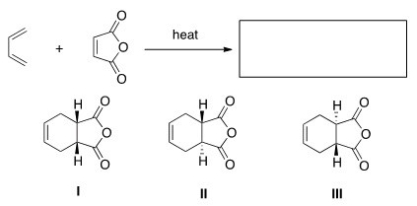
A)Only I
B)Only I and II
C)Only II and III
D)I,II,and III

A)Only I
B)Only I and II
C)Only II and III
D)I,II,and III

Unlock Deck
Unlock for access to all 53 flashcards in this deck.
Unlock Deck
k this deck
24
Which of the following electronic transitions is common in the UV spectrum of 1,3-butadiene?
A)s®p
B)s®p*
C)n ®p*
D)p®p*
A)s®p
B)s®p*
C)n ®p*
D)p®p*

Unlock Deck
Unlock for access to all 53 flashcards in this deck.
Unlock Deck
k this deck
25
What is the definition of a resonance structure?
A)Compounds with the same molecular formula
B)Compounds with different carbon frameworks
C)Structures that differ only in the placement of π and nonbonding electrons
D)Structures that differ only in the location of bonds
A)Compounds with the same molecular formula
B)Compounds with different carbon frameworks
C)Structures that differ only in the placement of π and nonbonding electrons
D)Structures that differ only in the location of bonds

Unlock Deck
Unlock for access to all 53 flashcards in this deck.
Unlock Deck
k this deck
26
Which of the following statements about the Diels-Alder reaction is true?
A)The diene can react only when it adopts the s-trans conformation.
B)Electron-withdrawing substituents in the diene increase reaction rate.
C)Electron-donating substituents in the dienophile increase the reaction rate.
D)The stereochemistry of the dienophile is retained in the product.
A)The diene can react only when it adopts the s-trans conformation.
B)Electron-withdrawing substituents in the diene increase reaction rate.
C)Electron-donating substituents in the dienophile increase the reaction rate.
D)The stereochemistry of the dienophile is retained in the product.

Unlock Deck
Unlock for access to all 53 flashcards in this deck.
Unlock Deck
k this deck
27
What is the major organic product of the following reaction? 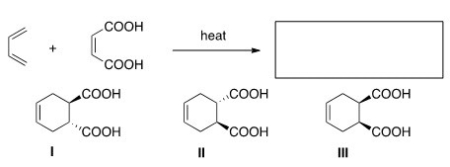
A)Only I
B)Only II
C)Only III
D)Only I and II

A)Only I
B)Only II
C)Only III
D)Only I and II

Unlock Deck
Unlock for access to all 53 flashcards in this deck.
Unlock Deck
k this deck
28
Which of the following compound absorbs UV light at the longest wavelength? 
A)I
B)II
C)III
D)IV

A)I
B)II
C)III
D)IV

Unlock Deck
Unlock for access to all 53 flashcards in this deck.
Unlock Deck
k this deck
29
Which of the following is not a feature of the Diels-Alder reaction?
A)They are initiated by peroxides.
B)They form new six-membered rings.
C)Three π bonds break.
D)They are concerted.
A)They are initiated by peroxides.
B)They form new six-membered rings.
C)Three π bonds break.
D)They are concerted.

Unlock Deck
Unlock for access to all 53 flashcards in this deck.
Unlock Deck
k this deck
30
Which of the following compounds is the most reactive dienophile in a Diels-Alder reaction? 
A)I
B)II
C)III
D)IV

A)I
B)II
C)III
D)IV

Unlock Deck
Unlock for access to all 53 flashcards in this deck.
Unlock Deck
k this deck
31
What is the major organic product of the following reaction? 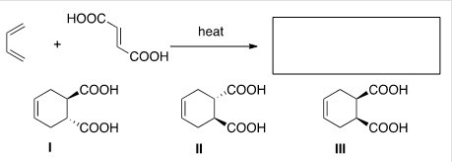
A)Only I
B)Only II
C)Only III
D)Only I and II

A)Only I
B)Only II
C)Only III
D)Only I and II

Unlock Deck
Unlock for access to all 53 flashcards in this deck.
Unlock Deck
k this deck
32
Which of the following is the least reactive diene in a Diels-Alder reaction? 
A)I
B)II
C)III
D)IV

A)I
B)II
C)III
D)IV

Unlock Deck
Unlock for access to all 53 flashcards in this deck.
Unlock Deck
k this deck
33
Rank the following dienophile in order of increasing reactivity in a Diels-Alder reaction,listing the least reactive first. 
A)I < II < III
B)III < I < II
C)II < I < III
D)III < II < I

A)I < II < III
B)III < I < II
C)II < I < III
D)III < II < I

Unlock Deck
Unlock for access to all 53 flashcards in this deck.
Unlock Deck
k this deck
34
Which of the following compounds is the least reactive dienophile in a Diels-Alder reaction? 
A)I
B)II
C)III
D)IV

A)I
B)II
C)III
D)IV

Unlock Deck
Unlock for access to all 53 flashcards in this deck.
Unlock Deck
k this deck
35
What is the major organic product of the following reaction? 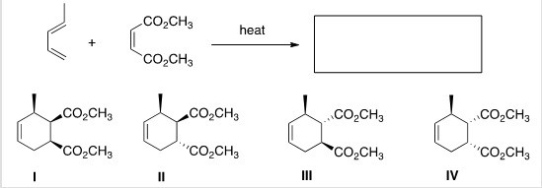
A)I
B)II
C)III
D)IV

A)I
B)II
C)III
D)IV

Unlock Deck
Unlock for access to all 53 flashcards in this deck.
Unlock Deck
k this deck
36
What diene and dienophile are used in a Diels-Alder reaction to prepare the following compound? 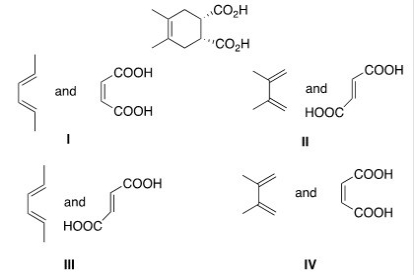
A)I
B)II
C)III
D)IV

A)I
B)II
C)III
D)IV

Unlock Deck
Unlock for access to all 53 flashcards in this deck.
Unlock Deck
k this deck
37
What is the major organic product of the following reaction? 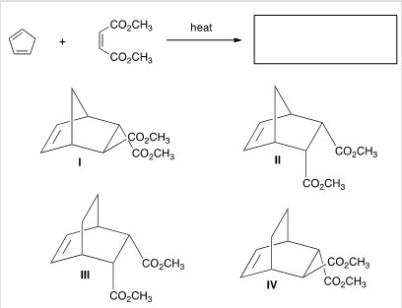
A)I
B)II
C)III
D)IV

A)I
B)II
C)III
D)IV

Unlock Deck
Unlock for access to all 53 flashcards in this deck.
Unlock Deck
k this deck
38
Which of the following is the least reactive diene in a Diels-Alder reaction? 
A)I
B)II
C)III
D)IV

A)I
B)II
C)III
D)IV

Unlock Deck
Unlock for access to all 53 flashcards in this deck.
Unlock Deck
k this deck
39
Which of the following compound absorbs UV light at the longest wavelength? 
A)I
B)II
C)III
D)IV

A)I
B)II
C)III
D)IV

Unlock Deck
Unlock for access to all 53 flashcards in this deck.
Unlock Deck
k this deck
40
What is the major organic product of the following reaction? 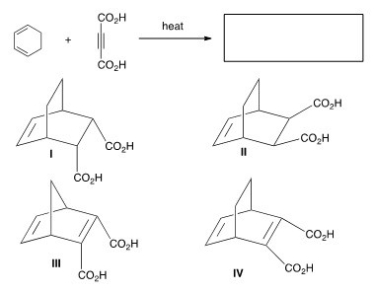
A)I
B)II
C)III
D)IV

A)I
B)II
C)III
D)IV

Unlock Deck
Unlock for access to all 53 flashcards in this deck.
Unlock Deck
k this deck
41
Which of the following is an example of a bridged bicyclic system? 
A)I
B)II
C)III
D)IV

A)I
B)II
C)III
D)IV

Unlock Deck
Unlock for access to all 53 flashcards in this deck.
Unlock Deck
k this deck
42
What is the major product of the following reaction? 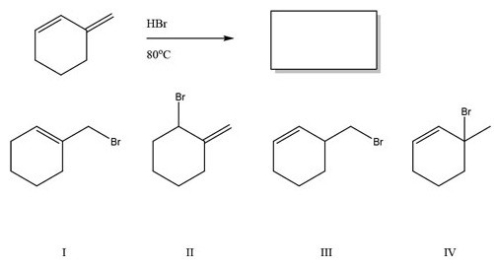
A)I
B)II
C)III
D)IV

A)I
B)II
C)III
D)IV

Unlock Deck
Unlock for access to all 53 flashcards in this deck.
Unlock Deck
k this deck
43
Why would the compound below not react with a dienophile in a Diels-Alder reaction? 
A)The compound is not a conjugated diene.
B)There are no electron withdrawing groups on the compound.
C)There are no electron donating groups on the compound.
D)The compound cannot adopt the s-cis conformation.

A)The compound is not a conjugated diene.
B)There are no electron withdrawing groups on the compound.
C)There are no electron donating groups on the compound.
D)The compound cannot adopt the s-cis conformation.

Unlock Deck
Unlock for access to all 53 flashcards in this deck.
Unlock Deck
k this deck
44
How would you favor the formation of the kinetic product of the following reaction? 
A)Excess HBr
B)Long reaction time
C)Low temperature
D)High pressure

A)Excess HBr
B)Long reaction time
C)Low temperature
D)High pressure

Unlock Deck
Unlock for access to all 53 flashcards in this deck.
Unlock Deck
k this deck
45
Which of the following is not a resonance structure of acetic anhydride? 
A)I
B)II
C)III
D)IV

A)I
B)II
C)III
D)IV

Unlock Deck
Unlock for access to all 53 flashcards in this deck.
Unlock Deck
k this deck
46
Which triene has the largest heat of hydrogenation? 
A)I
B)II
C)III
D)IV

A)I
B)II
C)III
D)IV

Unlock Deck
Unlock for access to all 53 flashcards in this deck.
Unlock Deck
k this deck
47
Which triene absorbs the longest wavelength of UV light? 
A)I
B)II
C)III
D)IV

A)I
B)II
C)III
D)IV

Unlock Deck
Unlock for access to all 53 flashcards in this deck.
Unlock Deck
k this deck
48
What is the major product of the following reaction? 
A)I
B)II
C)III
D)IV

A)I
B)II
C)III
D)IV

Unlock Deck
Unlock for access to all 53 flashcards in this deck.
Unlock Deck
k this deck
49
What is the major product of the following reaction? 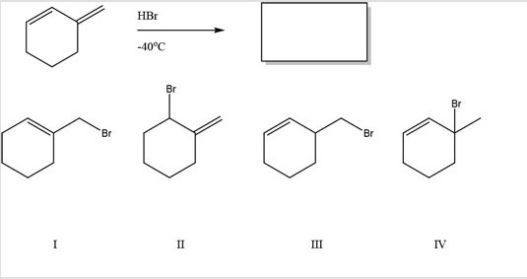
A)I
B)II
C)III
D)IV

A)I
B)II
C)III
D)IV

Unlock Deck
Unlock for access to all 53 flashcards in this deck.
Unlock Deck
k this deck
50
Rank the following anions from most to least stable,listing the most stable first. 
A)I> II > III
B)III > II > I
C)I > III > II
D)III > I > II

A)I> II > III
B)III > II > I
C)I > III > II
D)III > I > II

Unlock Deck
Unlock for access to all 53 flashcards in this deck.
Unlock Deck
k this deck
51
Which of the following is a major resonance contributor to the first structure? 
A)I
B)II
C)III
D)IV

A)I
B)II
C)III
D)IV

Unlock Deck
Unlock for access to all 53 flashcards in this deck.
Unlock Deck
k this deck
52
What is the major product of the following reaction? 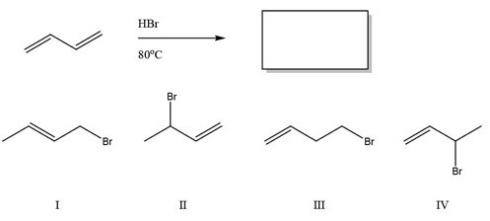
A)I
B)II
C)III
D)IV

A)I
B)II
C)III
D)IV

Unlock Deck
Unlock for access to all 53 flashcards in this deck.
Unlock Deck
k this deck
53
Which triene has the smallest heat of hydrogenation? 
A)I
B)II
C)III
D)IV

A)I
B)II
C)III
D)IV

Unlock Deck
Unlock for access to all 53 flashcards in this deck.
Unlock Deck
k this deck



